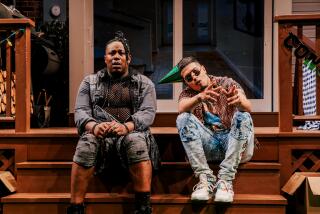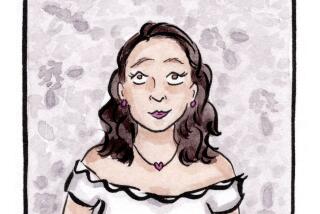Commentary: When will fat women be adequately represented on screen? There’s a test for that
We’ve come a long way from “Fat Monica.”
More than 20 years since the character appeared on “Friends,” it’s now widely accepted that the gag was offensive, designed for cheap laughs at a fat woman’s expense. Fat suits worn by thin actors — January Jones (“Mad Men”), Gwyneth Paltrow (“Shallow Hal”) and Eddie Murphy (“The Nutty Professor”) — are no longer de rigueur. And several recent series feature fat women as protagonists, including “This Is Us,” “Shrill,” “Dietland” and “Good Girls.”
Which raises the question: Is it enough simply to avoid outright fat-phobia, or should we expect more of such series than fat heroines consumed with their desire not to be fat? What if there were a “Bechdel test” for female body representation?
The original Bechdel test was named after a cartoonist, Alison Bechdel, who published a 1985 comic strip in which one of the characters outlined three rules for the movies she sees: First, the movie must have at least two women in it; second, they must talk to each other; and third, they must discuss something other than a man. Later versions of the Bechdel test added the rule that the women must be named.
Hearteningly, TV writers have begun to think more about the interiority of fat women, who represent a large percentage of the U.S. population — the average American woman weighs 170 pounds and has a body mass index of 29.6, just shy of being considered “obese.” But, as many other marginalized communities have stressed, mere representation is just the jumping off point, not the end goal. It’s not just about fat women being more visible on TV. A Bechdel-style test might pressure creators to tell more fat-positive stories about women who don’t hate their bodies.
The notion of a Bechdel-style test by which to measure such stories was inspired by Netflix’s “Orange Is the New Black,” which was revolutionary in its depiction of women’s bodies. The women at Litchfield prison were an accurate reflection of real-world body diversity. There were Cindy, Big Boo, DeMarco, CO Ginger and plenty of other “small fat” characters like Daya, Taystee, Red and Suzanne. Crucially, the women never talked about dieting or obsessed about their weight. To pass the test proposed here, TV series would essentially have to meet the “Orange Is the New Black” standard: Cast fat women in main roles and not have their story lines revolve around their weight or desire not to be fat.
NBC’s ‘This Is Us’ is renowned for its twists and turns, uncommon in a family drama. Creator Dan Fogelman and the stars explain how they make the mysteries.
Few shows would currently ace such an exam, including the most visible example, the hit drama “This Is Us.” As several critics have pointed out, Kate, played by Chrissy Metz, is frustrating because of the outsize focus on her fatness. “Kate is deserving of personhood and dynamism only during those times when her singular purpose is unfatting herself,” comedian Guy Branum wrote about the story line’s harmful messages: “Happiness and success are there for Kate, but ... only as part of her narrative of losing fat.”
During its fourth season, which concludes Tuesday, “This Is Us” has continued to reinforce those messages: In the wake of having a baby who is blind, Kate’s husband, Toby (Chris Sullivan), has lost weight, and much of the season has revolved around her resentment about that — and her worry that he has lost interest in her. When Toby chalks up his weight loss to stress about the baby in Episode 2, Kate responds, “Too bad it doesn’t work for me”: Even with a newborn with a disability, she’s still obsessing about her weight. It’s a creative decision that reinforces the fatphobic expectation that women should “bounce back” to their pre-baby weight as soon as possible, one exacerbated when Toby says that Kate, who is breastfeeding and thus needs to consume more calories, is “overeating” as a way of dealing with her feelings.
Melissa Zimdars, professor of communication and media at Merrimack College and author of “Watching Our Weights: The Contradictions of Televising Fatness in the ‘Obesity Epidemic,’” sees “This Is Us” differently. While she agrees that “We need representations that don’t mention fatness,” she also acknowledges the worth of addressing “the pressures that many people, especially women, still feel to be thin. We do see the character of Kate ... generally buying in to this pressure, which doesn’t really push our society toward fat liberation, but certainly reflects the experiences of many viewers who identify as fat.”
By contrast, “Shrill” ultimately offers a fat-positive narrative: It is, at heart, about a woman realizing that losing weight won’t make her happy. Starring Aidy Bryant as a writer named Annie — based on the real-life writer Lindy West — “Shrill” drew acclaim in its first season for its radical, affirming episode set at a “fat babe pool party.” But its second, which premiered on Hulu earlier this year, passes the adjusted Bechdel test with flying colors. In one scene at a restaurant with her boyfriend and parents, Annie combats the intergenerational internalized fat-phobia so often passed from mother to daughter: When her mom declines dessert because “I’ve been so bad with all the pasta and the bread,” Annie gloriously pushes back, “How have you been bad? It’s food.”
On the darker end of the spectrum is Netflix’s 2019 limited series “Unbelievable,” lauded for its nuanced portrayal of sexual assault and what can go wrong when women report it. The series represents diverse female bodies among the rape survivors, including one, played by Danielle Macdonald, whose arc challenges the myth that fat women don’t get sexually assaulted while also depicting the character with a loving boyfriend.
It’s decisions like these that go a long way toward reflecting fat women’s bodies and experiences back to them on the small screen. Giving fat female characters story lines that don’t revolve around their weight — as in “Orange Is the New Black,” “Shrill and “Unbelievable” — is the next step in helping destigmatize fat women in the real world.
The Netflix limited series “Unbelievable,” about a young woman accused of making a false rape allegation, shows how the system fails survivors of sexual assault.
Liz Sczudlo, a supervising producer on “Dynasty” who has also written for “Jane the Virgin,” “Switched at Birth,” “90210” and other shows, said that things have improved in terms of body representation, down to the size of the actors: “When I started at ‘90210’ 10 years ago, those actresses were very, very thin … all zeros or double zeros,” she said. “Now, It is absolutely normal to be a size 4 … which is still so small, but it’s an improvement.” Sczudlo also noted that there’s more sensitivity to the ways writers speak about actors’ bodies.
Still, Sczudlo feels there’s a stigma attached to advocating for diverse body sizes: “As a fat woman, I’ve never been on a show where I felt like there was ever a push for casting people who looked like me or even conversation about it.” And without a system-wide conversation in Hollywood, she doesn’t feel equipped to speak up. “I sold a show with a fat lead. And I was really psyched to make it and it didn’t work out,” she said. “But I think in my mind … I have to wait until I have a little more leverage personally to bring it up.”
For Kim Ndombe, who has written for “Raising Dion,” “Good Trouble” and “Sorry for Your Loss,” the biggest problem is that in most writers’ rooms, no one’s even thinking about body size: The default character is thin and fit. “We so rarely in the room write a character and say, ‘This could be somebody fat.’ … Unless it’s extremely purposeful,” she said. (In the latter case, she added, the character’s story line tends to revolve around their fatness.)
Ndombe underscored the importance of having fat people in writers’ rooms. As a black writer who’s sometimes been brought into a room to add a diverse perspective, she’s sensitive to tokenization, which can also happen if there’s only one fat writer. That’s why, even though she’s not fat, she can understand the desire for a Bechdel-like test that would ensure fat women aren’t all written as hating their bodies.
Among the barriers involved in challenging fat-phobia in Hollywood is the fact that, as Sczudlo explained, casting involves so many levels of approval. The first level is the casting director, whose “opinion on body size matters,” she said. If the casting director hasn’t received instructions to be body-inclusive, “they might not pass that person along to you.” Then the writer, director and showrunner weigh in, with the last making the decision about whom to pass on to studio casting and then, finally, network casting. In other words, as Sczudlo summed up, “For it to change, you would have to have a showrunner decide, ‘This is really important to me and I’m going to speak to both my casting director and studio and network casting so that we’re all on the same page.’”

A Bechdel test for female body representation is clearly aspirational at this point. Still, the extant examples of fat-positive storytelling in film and TV prove that it’s possible to write fat female characters who aren’t defined by their body size.
When I asked Ndombe and Sczudlo whether the whole idea was an absurd fantasy, they both pointed to a movie that would have passed the test: Olivia Wilde’s directing debut, “Booksmart.” Speaking about Molly, Beanie Feldstein’s character, Ndombe said, “They have these really cute characters talking about how cute she is and how they would totally [have sex with] her if it wasn’t for her personality. … That’s amazing.”
For Sczudlo, it was personal: “I’ve never felt so seen,” she said. “The problem isn’t her weight, the problem is that she’s annoying. And that was my problem in high school.”
More to Read
The complete guide to home viewing
Get Screen Gab for everything about the TV shows and streaming movies everyone’s talking about.
You may occasionally receive promotional content from the Los Angeles Times.







